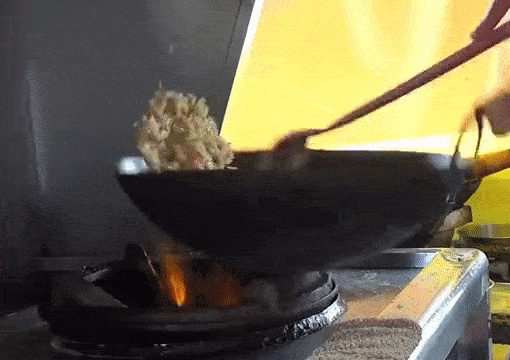Fried rice is a wonder of physics. Now, these researchers have finally unraveled its secrets, and the physics is spicy.

For centuries, fried rice has been a staple in many cuisines around the world. In addition to its trademark taste, it’s also a bit of a physical curiosity: it’s cooked at temperatures of 1200°C without burning. The key is a particular set of motions.
It’s no coincidence that 64.5% of Chinese restaurant chefs report shoulder pain — they need to maneuver the rice in a way that’s pretty difficult. Herein lies one of the motivations of the study: reducing injury and pain associated with rice cooking.
By studying the physics of rice frying and wok tossing kinematics, researchers hope to do two things: improve the process of frying rice, making for even more delicious meals and inspire exoskeletons to ease the stress on chefs.
It all starts with the wok
Fried rice is a part of most of the Asian cuisines. But it didn’t start as a way of ooking food. More than 1700 years ago, it was used to dry rice, making it last longer and have a more desirable taste. But it wasn’t that long before people also started to cook rice by stir-frying it.
Scattered gold rice, for instance, emerged from this technique some 1500 years ago. The reason why this type of dish is so sought after is because it provides the long-sought wok hei flavor — the “breath” of the wok. This refers to the aroma and essence imparted on the food by the wok’s heat and spices. In order to pass wok hei, the rice needs to be cooked over a high flame, and in order to avoid burning it, it must be stirred and tossed quickly.
Wok tossing is a very skill-dependent, and it is also mentioned both anecdotally and in the scientific literature as a concerning cause of musculoskeletal disorders among Chinese chefs.
David Hu, a fluid mechanics professor at the Georgia Institute of Technology, and his doctoral student Hungtang Ko, set out to see what specific technique is used in wok tossing, and how this can be replicated and improved, creating a physical model of rice frying.
“The goal of the model is to predict the airborne trajectories of the rice based on the kinematics of the wok. Our experiments indicate that the wok is moved in two dimensions; furthermore, the wok motion may be described by two degrees of freedom,” the study reads.
The moves
The researchers videotaped five professionals as they were stir-frying rice. They found that the wok toss has a period of 0.3 s and involves two directions of movement: translation, which slides the rice along the wok, and rotation, which throws the rice into the air.

With the rice inside, woks tend to be quite heavy. So chefs rarely lift it off of the stove. Instead, they maintain one point of contact and slide on it to another point, somewhat like a two-link pendulum.
The trajectory, position, and geometry of the wok can be mathematically modeled and compared to what was observed in the videos.

Armed with the newly obtained model, the two researchers also created a model for evaluating wok tosses and seeing which tosses will be successful and avoid dropping any rice.
This led to a sentence you don’t often see in scientific papers: “We simulated the wok tossing process in Matlab.” Here are the results:

Simply put, the optimal zone (marked by the dashed rectangle) indicates the best choices of frequencies and phase difference considering all the metrics. The black point at the lower boundary indicates the parameters used by professional chefs. This seems to suggest that chefs push the cooking method to its very limit by using the lowest possible frequency in the optimal zone. They are always one small step away from a mistake, but in this way, they optimize their movements.
But researchers also suggest that if researchers would improve the frequency of the movement, the fried rice might actually taste even better.
“We suggest that future chefs increase the frequency of motion, which may enable rice to jump further, and promote cooling and mixing,” the study reads — although, in truth, it’s hard to imagine that anyone would be happy to say that to a chef’s face.
Robot woks
Now that the movement is well-understood and documented, this could also pave the way for robot chefs.
This is not a new idea. Robot cooking has stirred interest for several decades, and there are already some practical applications. The researchers mention a restaurant based in Boston, USA, that uses rotating drums to mix and heat Chinese food at frequencies of 0.5 Hz. This is not a sufficient frequency, as indicated by this study. But the findings don’t just apply to one restaurant — they can be massively scaled.
“This study might inspire the construction of large-scale cooking machines. On the opening day of the 2008 Beijing Olympics, as much as 3000 kg of fried rice was consumed in the Olympic village,” the study writes.
No doubt, a number of restaurants would prefer having a robot do this intensive and consuming task, and this could save a lot of money and effort, while ensuring that everyone gets the fried rice we love so much.
The study has been published in The Royal Society Publishing.


